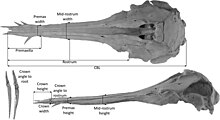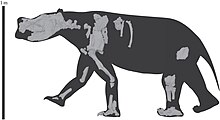Afrotherians
Proboscideans
| Name | Novelty | Status | Authors | Age | Type locality | Country | Notes | Images |
|---|---|---|---|---|---|---|---|---|
|
Stenobelodon[1] |
Gen. et comb. nov |
Lambert |
Miocene |
A new genus for "Amebelodon" floridanus (Leidy, 1886). |
Proboscidean research
- Review of the systematics and evolutionary history of African proboscideans is published by Sanders (2023).[2]
- A study on the evolution of teeth of proboscideans from East Africa over the past 26 million years is published by Saarinen & Lister (2023), who find evidence of ratchet-like mode of evolution, with periods of rapid increase in hypsodonty and loph count (probably related to episodes of increase of aridity) alternating with longer periods of relative stasis rather than reversal of these traits.[3]
- Choudhary et al. (2023) report the first discovery of the fossil material of a mammutid (cf. Zygolophodon) from the Upper Miocene deposits of Tapar (Kutch, India), extending known temporal range of mammutids in the southern Himalayan foreland basin to ~10 million years ago.[4]
- Fossil material of a mammutid distinct from the more basal Zygolophodon and possibly belonging to the species "Mammut" obliquelophus is described from the Upper Miocene locality of Sazak (Turkey) by Konidaris et al. (2023), representing the first record of "Mammut" in the Upper Miocene of western Asia reported to date, and interpreted by the authors as supporting the existence of a zoogeographic link enabling proboscidean interchanges between Europe and East Asia during the Late Miocene.[5]
- Von Koenigswald, Widga & Göhlich (2023) describe fossil material of mammutids from Oregon (partial skull of Zygolophodon proavus from the Clarendonian Ironside Formation, a maxilla of a mammutid of uncertain affinities – tentatively classified as "Mammut furlongi" – from the Clarendonian Juntura Formation, and partial skull of Mammut matthewi from the Hemphillian Dalles Formation), and interpret the Miocene and Pliocene record of North American mammutid as indicating that Mammut most likely did not immigrate into North America from Eurasia but rather evolved from Zygolophodon in North America.[6]
- Li, Chen & Wang (2023) reinterpret "Trilophodon" connexus as a member of the family Choerolophodontidae, and provisionally assign it to the genus Choerolophodon.[7]
- Revision of the gomphothere faunas of the Miocene Linxia Basin (China) is published by Wang et al. (2023), who report the presence of three fossil assemblages of different age.[8]
- A study on the morphology and feeding ecology of longirostrine gomphotheres from the Early–Middle Miocene of northern China is published by Li et al. (2023), who interpret Platybelodon as the first known proboscidean that evolved both grazing behavior and trunk coiling and grasping functions, making it better adapted to the open environment than other longirostrine taxa, and interpret these adaptations as eventually resulting in the feeding function shifting from the mandibular symphysis and tusks to the trunk.[9]
- Neves et al. (2023) study carbon and oxygen isotopic signatures from samples of dentin of a specimen of Notiomastodon platensis from the Sousa municipality (Brazil) living during the Last Glacial Maximum, and interpret their findings as indicating that the studied specimen lived in a wetter environment compared to other localities from the Brazilian Intertropical Region and had mixed-feeder diet.[10]
- Konidaris et al. (2023) describe fossil material of Deinotherium levius and Tetralophodon longirostris from the Hammerschmiede clay pit (Germany), report evidence of their feeding habits indicative of niche partitioning between the two species which made their coexistence at Hammerschmiede possible, and interpret their presence at the site (coupled with the absence of Gomphotherium at Hammerschmiede to date) as documenting the transition from the Middle Miocene trilophodont (Gomphotherium)-dominated proboscidean faunas of central Europe to the Late Miocene tetralophodont-dominated ones.[11]
- Romano et al. (2023) estimate the body mass of Anancus arvernensis to be between 5.2 and 6 tonnes.[12]
- Lin et al. (2023) recover complete mitogenome from a molar of a member of the genus Palaeoloxodon and partial mitochondrial sequences from another member of this genus (both from the Pleistocene of China), and interpret the studied specimens as possible representatives of a population with a large spatial span across Eurasia.[13]
- A study on woolly mammoth genomes, identifying genetic variants associated with hair and skin development, fat storage and metabolism, and immune system function that had become fixed in the woolly mammoth lineage, is published by Díez-del-Molino et al. (2023).[14]
- A study on the accumulation of woolly mammoth bones from the Upper Paleolithic site Kostenki 14 (Markina Gora, Voronezh Oblast, Russia), aiming to assess relations between the body size of Kostenki mammoths, the state of their population and the timeframe of bone assemblage accumulation, is published by Petrova et al. (2023), who interpret their findings as indicative of relatively long-term inhabitation of the studied area by mammoths and permanent visitation of the site.[15]
- Evidence from tooth enamel of a woolly mammoth from the Upper Paleolithic Kraków Spadzista site (Poland), interpreted as indicating that the studied mammoth grazed in southern Poland in winter time and likely moved 250–400 km northwards during summer throughout at least 12–13 years of its adult life, is presented by Kowalik et al. (2023).[16]
- Cherney et al. (2023) study steroid hormone concentrations in woolly mammoth tusk dentin, and report evidence periodic increases in testosterone, interpreted as indicating that male mammoths experienced episodes of musth similar to those occurring in extant African elephants.[17]
- Larramendi (2023) provides a formula for estimating tusk weight in proboscideans and conducts a review of tusk size evolution in Proboscidea.[18]
Sirenians
Sirenian research
- Evidence of adaptation of motor-sensorial systems which were originally associated with tooth innervation to innervation of novel keratinized structures in sirenians, based on data from the study of extant and extinct sirenians, is presented by Hautier et al. (2023).[19]
- Probable new specimen of Prototherium ausetanum, complementing the available information of the anatomy of that species, is described from the Eocene (Bartonian) limestone south of Sant Vicenç de Castellet (Catalonia, Spain) by Voss et al. (2023).[20]
Other afrotherians
| Name | Novelty | Status | Authors | Age | Type locality | Country | Notes | Images |
|---|---|---|---|---|---|---|---|---|
| Europotamogale[21] | Gen. et sp. nov | Valid | Crespo, Cruzado-Caballero, & Castillo | Pliocene | A member of Afrosoricida. The type species is E. melkarti. | |||
|
Gen. et sp. nov |
Gheerbrant |
Paleocene |
A basal member of Paenungulatomorpha. The type species is H. phosphaticus. |
Miscellaneous afrotherian research
- A study on teeth and affinities of Qarunavus meyeri is published by Kampouridis et al. (2023), who place Qarunavus in the family Ptolemaiidae, and interpret the eruption sequence of the permanent teeth of Qarunavus as potentially supporting the placement of Ptolemaiida within Afrotheria.[23]
- Lihoreau et al. (2023) describe a tooth of an embrithopod belonging to the genus Palaeoamasia from the Eocene Lopar Sandstone (Croatia), extending known geographic range of members of this genus, and interpret this finding as consistent with the existence of the isolated Balkanatolian landmass which was isolated from Western Europe prior to the Grande Coupure.[24]









